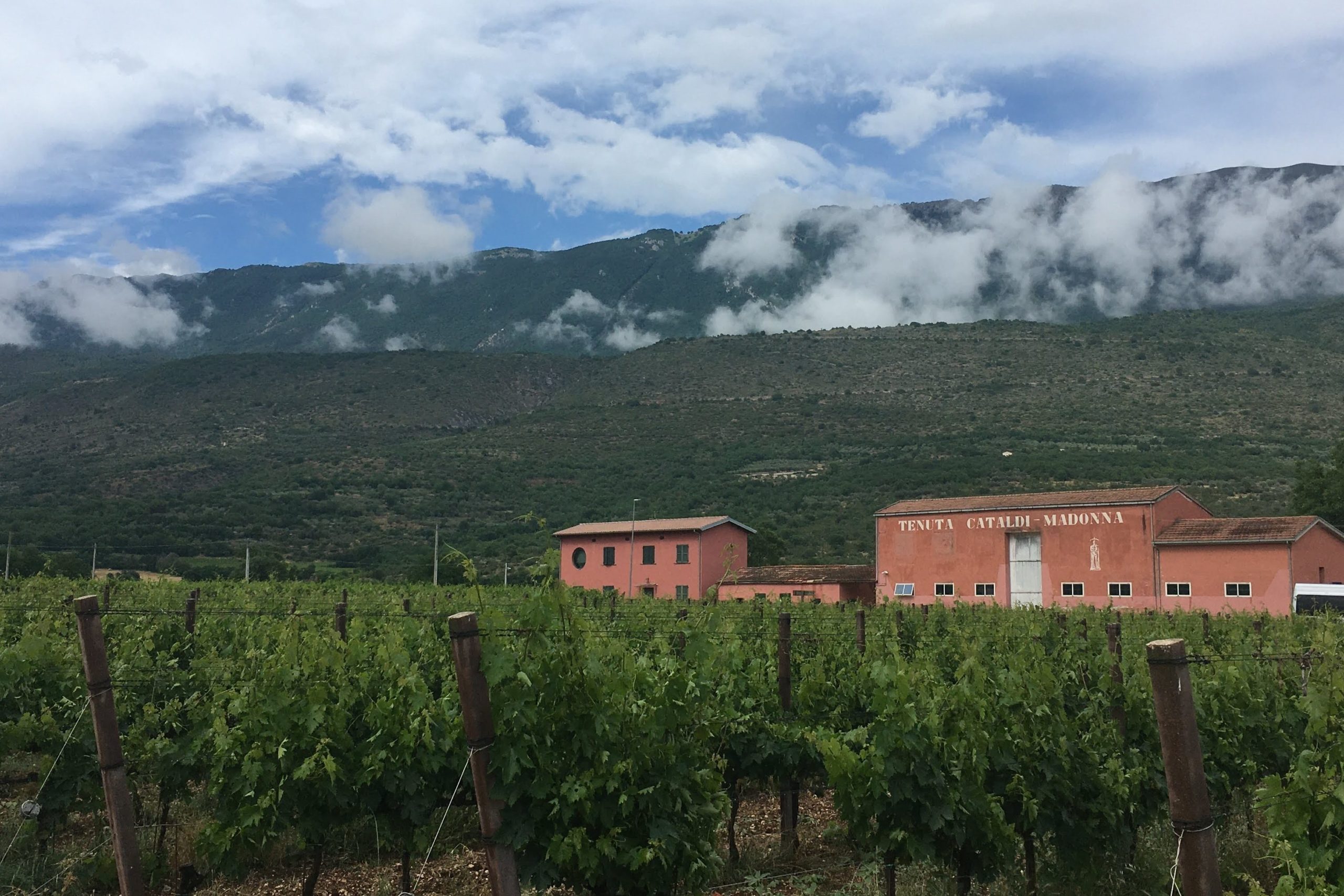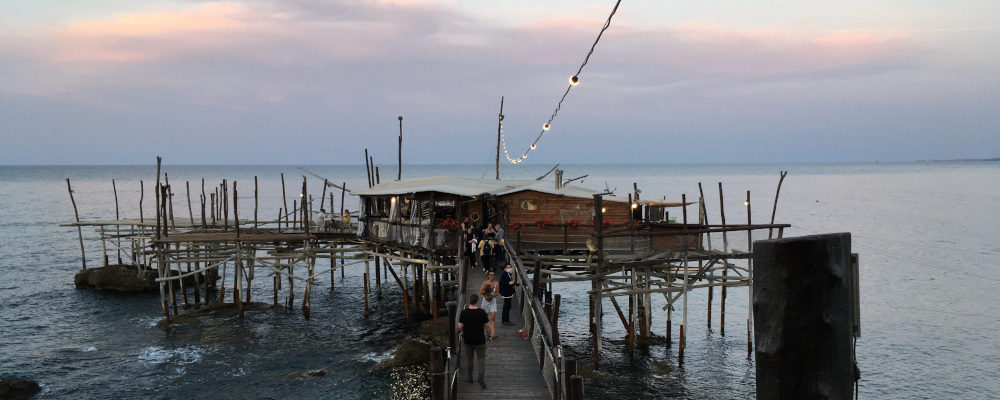A trabocco is a kind of shack on a pier that juts out from the beach into the waters of the Adriatic on the coast of Italy’s Abruzzo region. Festooned with poles and nets, it’s a machine for catching fish; an ancient technology said to be developed by the Phoenicians. Along what’s known as the Trabocchi Coast, stretching south from the aptly named seaside town of Pescara, they dot the shoreline every 500 meters or so. Some are still used to catch fish, but many have been converted to restaurants that feed tourists fresh seafood.1“Trabucchi were built in the most prominent promontories, jutting nets out to sea through a system of monumental wooden arms. The development of the trabucchi allowed fishing without being submitted to sea conditions using the morphology of the rocky coast of Gargano.
The trabucco is built with traditional wood Aleppo pine -the typical pine of Gargano and common throughout the South-Western Adriatic- because this material is widely available in the region, modeled, elastic, weatherproof and resistant to salt (trabucco must resist to strong winds of Provence usually blowing in these areas). Some trabucchi have been rebuilt in recent years, thanks to public funds. However, since they lost their economic function in the past centuries when they were the main economical source of entire families of fishermen, trabucchi rose into the role of cultural and architectural symbols and tourist attraction.” https://en.wikipedia.org/wiki/Trabucco
I found myself having dinner in a trabocco last week when I traveled to Italy as a guest of the Consorzio di Tutela Vine d’Abruzzo. I was there for the Abruzzo Wine Experience which took place in the old Duke’s palace in Vasto and served as an “ante prima”, or preview, of the wines coming to market from the region. Before and after the grand tasting event, I travelled throughout the region visiting wineries and enjoying Trebbiano d’Abruzzo, Pecorino, Cerasuolo, and Montepulciano in their natural habitat.
Showing the wines in their native setting was the point of the dinner in the trabocco, explained my host, the consortium’s president Valentino di Campli. In North America we think of wine as a drink, but in Italy it’s more like a food, or an ingredient among others in a meal. In my experience, one of the highest compliments one can give an Italian winemaker is their wine is gastronomico.
At the table, the slightly oily character of Trebbiano d’Abruzzo reveals itself next to an octopus salad. The citrus and saline character of Pecorino becomes that much more apparent accompanying a breaded and fried sardine. And the bright red fruit character of Ceruasolo d’Abruzzo, the region’s answer to rosé, sings with a dish of sea snails in a sauce of tomato and garlic. For Montepulciano d’Abruzzo, though, I would have to go back up into the mountains.
Visitors to Rome might be aware of the big hills in the distance to the southeast. These are the The Apennines, the spine of mountains that runs down peninsular Italy and dominates the geography of Abruzzo.2“Apennine Range, also called the Apennines, Italian Appennino, series of mountain ranges bordered by narrow coastlands that form the physical backbone of peninsular Italy. From Cadibona Pass in the northwest, close to the Maritime Alps, they form a great arc, which extends as far as the Egadi Islands to the west of Sicily. Their total length is approximately 870 miles (1,400 kilometres), and their width ranges from 25 to 125 miles.” https://www.britannica.com/place/Apennine-Range On the three-hour drive from the capital to Ortona the mountains rise quickly and don’t let up until they tumble into the coast. The highest ranges of the Apennines are in Abruzzo, and some snow remained on their craggy peaks. I had read, and have repeated, that Abruzzo has the twin most desirable moderating characteristics of a Mediterranean wine-producing region, altitude and coastline, but until I saw it, I didn’t understand how dramatically they manifest.
North of Pescara, in the foothills between the sea and the Gran Sasso massif are wineries that include a trio of forward-thinking organic producers making high-quality versions of the essential Abruzzese wines: Trebbiano and Pecorino for white, Cerasuolo for pink (or light red), and Montepulciano d’Abruzzo for serious red. They are Abbazio di Propezzano, Strappelli, and the renowned Emidio Pepe. Emidio Pepe is 90 years old and considered a pioneer of Abruzzese fine wine, having begun to be noticed by the world’s critics in the 1970s. I travelled with a vanful of American and Canadian journalists to all three in that order one day, finishing with dinner at the restaurant run by the Pepe family at their winery and farm.
At Emidio Pepe, once we were greeted by il signor e la signora Pepe, we were taken under the wing of their granddaughter Chiara De lulis Pepe, who is taking over responsibility for the production of their sought-after organic wine. She showed us the vineyards that roll through the hills at the foot of Italy’s highest mountains south of the Alps. The vineyards were interspersed with olive and citrus groves and fields of wheat, spelt, and chickpeas.
She explained that she followed the example of her grandfather to make fine wines that were made to age and evoked this particular place, roughly halfway between the sea and the Gran Sasso range. Explained, later in the cellar, that her family’s wines were elevated simply in concrete tanks, meaning the vintages of Emidio Pepe wines could vary greatly in taste. Said: “The responsibility of the winemaker is to bottle something that is true to the season.”
At dinner, Chiara Pepe proved her points by example. Around a long table near the winery restaurant’s kitchen we were served a seven-course meal by her younger sister and brother, who work in the vineyards and cellar as well. The meal focused on ingredients from the farm and the hills of Abruzzo, if they didn’t grow or raise it themselves. Chiara Pepe told us that one of the few silver linings of the COVID pandemic was their ability to recruit Chef Pietro La Rosa, a native of Palermo, trained in San Sebastian and working in Copenhagen until the pandemic hit. The food was Alta Cucina, but also down to earth, a lot like the wines.
There is magic in those hills and in that cellar.
We tasted (well, drank) nine wines throughout the dinner: Trebbiano d’Abruzzo 2019, 2009, and 2004 to start. As the wines got older, they seemed to become more vibrant. Then, we had a stunning Pecorino from 2013, redolent with orange peel and white flowers. Then onto the reds, which could have only been Montepulciano d’Abruzzo. Here was a deep trip back in time: 2007, 2003, 2002, 2001, and finally 1983. Oddly again the last two seemed more alive and resonant than the first three. There is magic in those hills and in that cellar.
On our last day, our van of merry wine writers found ourselves back high up in the hills in the Pescara Valley on the other side of the Gran Sasso from Emidio Pepe. There we visited Cataldi Madonna, which like Emidio Pepe is being taken over by a young woman and third-generation winemaker, Giulia Cataldi Madonna, who gave us a tour and took us to lunch and a tasting of her family’s wines.
At one point in the not-so-distant past, the Cataldi family processed most of the grapes grown in the valley, which is crowned at each end by the ancient hilltop towns of Ofena and Capestrano. As if to nod to the family’s humble past, Giulia Cataldi Madonna showed us her bottling line as it was filling up a bag-in-box label of Montepulciano d’Abruzzo. We learned that this was a relatively modern winery; the family’s original was in a very old stone building at the very top of Ofena, and that’s where we headed, after the tour, for lunch.
Lunch was not cooked by a fancy young chef, but rather by a local lady with deep experience of the local foodways. It was served buffet style and offered such an array of mountain specialties that it was difficult to get everything on one plate. Giulia Cataldi Madonna explained that this would be a light lunch because there was no pasta. Instead, for starch there was a kind of small fried “pizza” bread and, in a tangy fresh tomato sauce, pallotte cace e ove. This specialty of Abruzzo, which none of the visitors had tried before, is dumpling balls made of old bread, eggs, and cheese and is absolutely delicious.

Throughout lunch we tasted through Cataldi Madonna’s higher-end wines, starting with their fundamental selections and graduating to single-vineyard versions. For whites, we had the Trebbiano d’Abruzzo 2021 and the Pecorino 2021 and the “SuperGiulia” Pecorino 2019, whose intensity woke up the palate and made room for more pallotte. Then onto the Cerasuoli: the 2021 and then the Pie Delle Vigne 2019, which Giolia Cataldi Madonna described as “somewhere in the middle between red and white”, and which went particularly well with the multiple varieties of local salumi and cheeses.
For the reds, things got serious when we were presented with Abruzzo’s great contribution to meat on a stick: arrosticini. These were small cubes of local lamb, simply seasoned with salt and olive oil, grilled over coals. Sometimes known as spiedini or speducci, they complemented the inky herbal Malandrino 2020 and then the tarry and aromatic Tonì 2018 Montepulciano d’Abruzzo.
I went to Abruzzo and learned three things from three meals. Abruzzese whites are particularly suited to fresh seafood. Their high-end wines, particularly when aged, have a place of prominence in the most prestigious restaurants. And their wines go very well with cheese balls, meat on a stick, or any other good old home-cooked meal.
Websites for the wineries in this column are:
https://www.emidiopepe.com/en/
And for the Consorzio di Tutela Vine d’Abruzzo:




